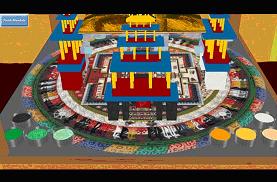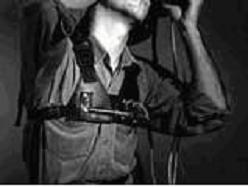 |
TITLE:
Pranic Interface: Developing A Subtle Breathing Centered Interface For Navigating
Cosmographic Spaces And Mythological Content (Narrative)
CLIENT:
Niranjan Rajah (SIAT)
CONTACT:
- CONTEXT: The Pranic (breath) Interface project is a component of a wider research agenda that examines the use of digital technologies for worship, contemplation, for the presentation of mythological content and for the development of spiritual practices. This wider research involves an engagement with and extension of the discourse of post-traditional media (Rajah) and the practice of culturally reflective computing (Makkuni). All the physical and metaphysical arts and sciences of the Hindu/Buddhist, Jaina traditions are premised on breath control. The Pranic (breath) Interface project takes as its point of departure the interface developed of Char Davis and John Harrison in their development of a breath and balance interface for navigating the immersive Virtual Reality (VR) spaces of ‘Osmose’. Other referenced technologies include Dublin Media Labs Breath Sensors; Rebecca Allen’s interface that allows you to effect changes in a landscape just blowing.; and Thecla Schiphorst’s Exhale which uses the networked breath as an interface for sharing our bodies' affective data.


- PROJECT GOALS: This Pranic Interface Project will encompass theoretical, ethnographic, design, engineering, programming, theological and aesthetic aspects of developing a breath interface in the context of the remediation of traditional and Post-Traditional Indian cosmographical and mythological representations. The research method is a combination of artistic, ethnographic and design approaches, combining theory with practical implementations through iterative loops. Project team will work closely with the team developing project TITLE: 3D Hindu Temple Remix System: Building a Navigable Post-Traditional Cosmographic Representation which will be developing a compatible 3D realm. The specific goals of this project are –
- To articulate a specific theoretical basis for the breath interface within the context of Post traditional theory, culturally reflective computing and Human Computer Interaction.
- To develop the criteria for the evaluation of a Pranic interface in its ability to augment the bio and psychic technologies of image worship, meditation and Yoga.
- To study and evaluate the various existing types of breath interface.
- To design, produce, implement and test a culturally specific breath interface that will be capable of navigating and articulating the metaphors and meanings of the esoteric diagrams, iconic forms, meditative and performative techniques of traditional cosmolographical and mythological representations.
DELIVERABLES: The specific deliverables are -
- To submit bi-weekly status reports, design review, requirements and specifications documents, which will also need to be reworked as required to transform them into components for a co-authored (With Client) paper on the subject for publication in one of the relevant international journals.
- To develop a range of concept design and mock-ups.
- To select the best design concept and develop various iterations of a prototype culminating in final version and documentation. of a working prototype that can be presented in late spring 2009.
- To develop a press kit and information and to use these to stage a press conference and attract media coverage.
SKILLS REQUIRED: A team with members with skills in designing and prototyping rudimentary hardware for interactive systems, navigational systems; skills in programming (JAVA, arduino), project management skills. Specific Technical Skills or Experience: Soldering, Scavenging, Arduino development and debugging in wiring or ruby (http://rad.rubyforge.org/)
Highly Recommended:Object Oriented Programming confidence/experience
Encouraged:Ability to use code repositories ( http://github.com )If using ruby, highly recommend a "test first" approach with RSpec ( http://rspec.info )
From Courses:
http://www.siat.sfu.ca/undergrad/courses/2008/1/IAT-267/
Ability to read circuit diagrams and integrated circuit (chip) specification documents working knowledge of how to shop for and evaluate electronic components. Experience building and debugging simple circuits with chips will be a competitive advantage.
http://www.siat.sfu.ca/undergrad/courses/2006/3/IAT-265/
Use debuggers, profiles, testing tools, rapid prototyping tools, and integrated development environments to improve their programs and the process used to develop them. Use and apply event-oriented and object-oriented programming techniques.
http://www.siat.sfu.ca/undergrad/courses/2007/1/IAT-320/
Experience successfully constructing: an interaction system, which explores the detection of body movement and gesture in space.
http://www.siat.sfu.ca/undergrad/courses/2007/1/IAT-323/
Research, design, construct, present and critically analyze a collaborative media performance or installation situated through the filter of locative media and physical and/or virtual networks.
http://www.siat.sfu.ca/undergrad/courses/2006/3/IAT-338/ -Applicable to this project
http://www.siat.sfu.ca/undergrad/courses/2006/3/IAT-301/- Highly applicable
Further Relevant Courses :
http://www.siat.sfu.ca/undergrad/courses/2006/3/IAT-422/
http://www.siat.sfu.ca/undergrad/courses/2006/3/IAT-302/
http://www.siat.sfu.ca/undergrad/courses/2007/3/IAT-338/
REFERENCES: Preliminary reading includes -
COOMARASWAMY, A. K. (1956). "Christian and Oriental Philosophy of Art". In: Christian
and Oriental Philosophy of Art. New York: Dover
DAVIES C. and J. HARRISON, "Osmose: Towards Broadening the Aesthetics of Virtual
Reality", first published in ACM Computer Graphics: Virtual Reality, XXX: 4, 1996
http://www.immersence.com/os_notes02.htm
RAJAH, N. and R. Srinivasan, “Sacred Art in a Digital Era” in Reframing Consciousness, ed.
Roy Ascott, Intellect Books, Bristol/ Portland (pp.56-61), 1999
SHIPHORST, T. “Breath, skin and clothing: Using wearable technologies as an interface into
ourselves” in International Journal of Performance Arts and Digital Media , Volume: 2 |
Issue: 2, October 2006 Page(s): 171-186